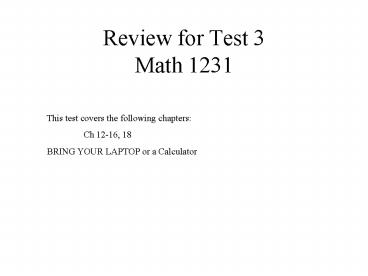Review for Test 3 Math 1231 PowerPoint PPT Presentation
1 / 13
Title: Review for Test 3 Math 1231
1
Review for Test 3Math 1231
This test covers the following chapters Ch
12-16, 18 BRING YOUR LAPTOP or a Calculator
2
Randomness
- Random event outcomes of individual events are
uncertain, such as rolling a die. But a regular
distribution of outcomes is seen in a large
number of repetitions. - Random events cannot be predicted with certainty
in advance. - Know how to use a random number table to simulate
random events.
3
Objectives You should
- Be able to identify the Ws (Who, What, Why,
How, When?) This means. - If given a description of a study
- Be able to identify the sample (how many of
what?) - Identify the population (what is the entire group
of individuals we want info about?) - Identify the variable measured.
4
More Objectives
- Be able to identify explanatory and response
variables in experiments - Be able to distinguish between surveys,
observational studies and experiments. - Be able to recognize different sampling methods-
SRS, stratified, etc. - Be able to locate problems (sources of bias) with
the design of a study - Voluntary Response Samples (why does this cause
bias?) - Undercoverage
- Non-Response
- Wording of questions, Response Bias, etc.
- Experiments not Random Comparative Design
- Confounding of variables in experiments
5
It keeps going
- Know the properties of a good experiment
- Controls all factors but the ones being studied
- Randomly assigns subject to treatments/factors
- Replicates experiment (many subjects)
- Provides strong evidence for cause-and-effect
- Controls placebo effect (if applicable)
- Double-blind, if possible (why?)
- Know how to draw out a design diagram for an
experiment. - Parameter number that describes a population.
Not known. - Statistic number calculated from sample data.
Used to estimate parameters.
6
Review Probability
- Random event individual events uncertain, such
as rolling a die. But a regular distribution of
outcomes seen in large number of repetitions. - The probability of an event is the proportion of
times that outcome occurs in very large number of
trials. - Law of Large Numbers- the relative frequency will
approach the true relative frequency as number of
trials increases.
7
Basic Probability Rules
- The probabilities of all possible outcomes must
sum to 1. - Either a particular outcome occurs or it doesnt.
So - P(not A) 1-P(A) (Compliment Rule)
- P(A) 1- P(not A)
- Disjoint Outcomes cannot happen at same time. I
cannot roll a 1 and a 2 on a single die roll. The
outcomes are disjoint. - P(A or B) P(A) P(B) for disjoint events.
(Addition Rule) - Independent Events are independent if knowing
that one event occurs does not change the
probability of the second event happening.
(Multiplication Rule) - P(A and B) P(A)P(B) for independent events.
8
More Basic Probability Rules
- Example P(at least one person passes Test 5)
1-P(no one passes) - Sample Space List of all possible outcomes of an
event. - General Addition rule Does not require disjoint
outcomes - P(A or B) P(A) P(B) P(A and B)
- Conditional Probability If events are not
independent, then knowing that one outcome occurs
can change the probability of a second outcome
occurring. - P(A and B) P(A)P(BA) does not require
independence - Prob of A and B Prob of A Prob of B given A.
- P(A and B) P(B)P(AB) also.
9
- In a contingency table, the condition restricts
the who (pool). - Example Given that a randomly selected student
is male, what is the probability that he passed
Test 3? - Number of males that passed/total number of
males. - Expected Value like a weighted average. Know how
to calculate!
10
Random Variables and Sampling Distributions
- Sample proportions are used to estimate
population proportions. - Law of Large Numbers Averaged observed outcome
(sample mean) guaranteed to be close to
population mean in the LONG RUN (large sample
size/many repetitions) - Statistics vary in repeated samples- sampling
variability. - The distribution of sample proportions is the
sampling distribution- describes values taken on
by RV in all possible samples. - Statistics from larger samples are less variable!
11
Sampling Distribution Proportions
- The sampling distribution of the sample
proportion has - Normal distribution, N(p, )
- Mean equal to the population proportion, p
- Standard deviation equal to
- z-score
- The statistic that estimate the true proportion
of something is the sample proportion, phat. - phat count of successes/n
- Assumptions/Conditions Random Sample
- Independence of values
- Sample less than 10 pop.
12
Sampling Distributions Proportions
- The sampling distribution model shows the
behavior of the sample proportion over ALL the
possible samples. - As sample size increases, the sampling
distribution becomes LESS VARIABLE (ie, sigma
decreases!). - The Central Limit Theorem (CLT) tells us that
the sampling distribution of the sample
proportion (or mean) is approximately Normal for
large n, regardless of the population, as long as
observations are independent.
13
Study Suggestions
- If you havent already, DO THE HOMEWORK!
- Review Quiz 5 and 6 and the MathXL homework,
particularly any questions you missed. - Solutions to all quizzes are/will be online
- Think about what the big idea is that each
question is trying to ask. - Work Practice Test from Website
- Work Suggested problems in the Reviews in the
book - Email or IM Dr. Matos with questions, or use
office hours! - Make sure youve gone through ActivStats!

